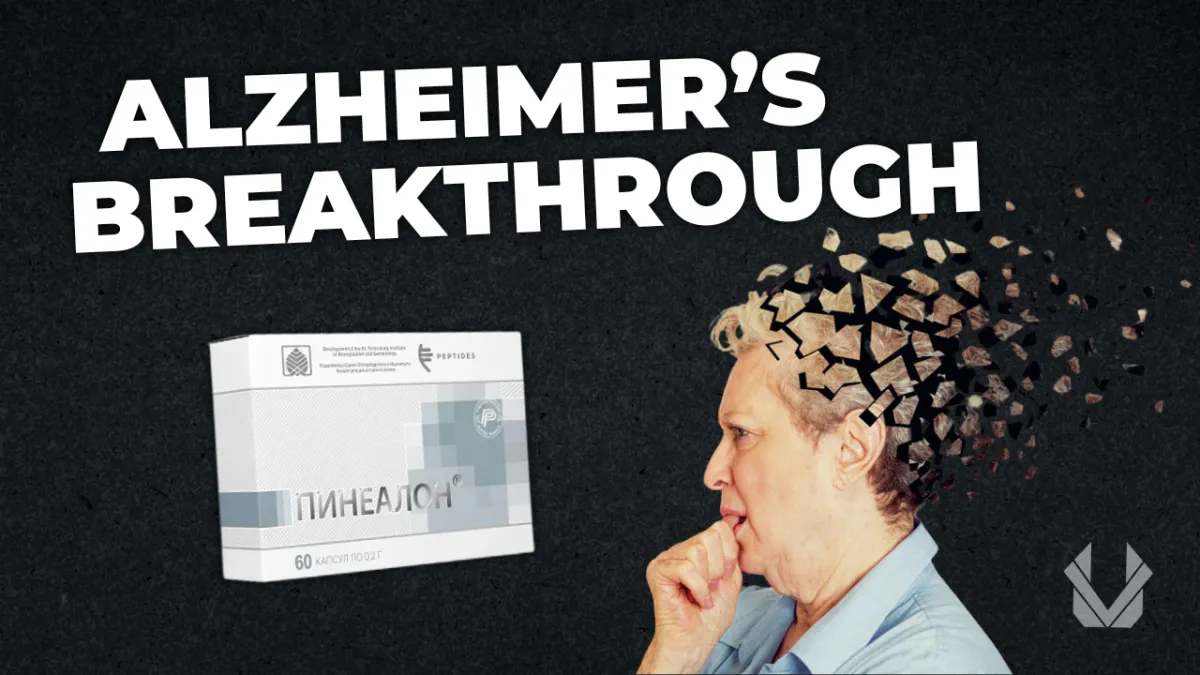THE UNYIELDING VIGOR BLOG
Our goal is to give you the most scientifically accurate and POWERFUL biological enhancement resources in the world
We're here to set new standards for truth, accuracy and effectiveness in the health industry. You'll find more value and scientific proof in our free articles than in most content you pay for.

Life-Changing Alzheimer's Breakthrough: A New Hope With Peptide Science
The following is a transcript from the video
If you have a loved one suffering from Alzheimer's, this could considerably enhance their quality of life, so please, pay close attention. This isn't just about improving symptoms of Alzheimer's disease. It's also about regenerating some of the losses.
Something that Western medicine would tell you is impossible. Stick with me because the science is truly fascinating here, and after hearing it, you'll understand more about Alzheimer's disease than most neuroscientists. It was Christmas Eve about ten years ago when my grandma called me, panicked and convinced that someone had just been in her house.
I rushed over to check on her. When I arrived, she greeted me at the door and was really distraught, but upon checking, everything seemed to be okay in her house. No one was there, all her personal belongings, her purse, everything was still there.
My grandma was never one to lie or overreact. She was a very honest, straightforward, spirited, and calm woman. Still, the fear and confusion in her eyes were undeniable.
Over the next few months, similar calls became more frequent. Not long after, my once sharp and always spirited grandmother was diagnosed with Alzheimer's disease, and watching her struggle with the memory loss, the confusion, hallucinations, and especially the depression was heartbreaking. Alzheimer's disease doesn't just steal memories.
It robs us of our loved ones. Currently, mainstream medicine offers no known cure for Alzheimer's. The best available treatments, like acetylcholinesterase inhibitors, attempt to enhance memory by boosting neurotransmitter levels.
However, they merely mask symptoms while neurons continue to degenerate. The spines on our synapses, which are needed for proper neural signaling, are destroyed by Alzheimer's, and toxic amyloid plaque further accelerates neuronal losses. Studies suggest that when a person gets Alzheimer's, their life expectancy gets reduced to only 5-10 years at best, and these years can be painful for both the patient and the caregiver.
But what if we could change that? What if a simple, naturally occurring peptide could reverse this damage? Well, it can, and in this video, you'll discover how a tripeptide called pinnulon, with the sequence glu-asparge, works at a deeper level to repair and regenerate brain tissue that is lost from Alzheimer's disease, while also slowing down the progression, and improving cognition. This approach can not only extend life, but also significantly alleviate almost all of their neural degeneration. This is such a powerful and life-changing approach to healing Alzheimer's, yet most people have never even heard of it, which is why I'm so passionate about sharing this.
First, I'll explain what Alzheimer's is, its causes, and the brain changes it triggers. Then I'll delve into the science behind current treatment methods. Finally, I'll reveal how this miracle peptide called pinnulon can almost completely reverse the memory loss effects of Alzheimer's in ways unmatched by Western medicine.
So why aren't more people talking about this? Well, Big Pharma can't patent such a peptide. It's already been patented by Professor Kovinson himself, a Russian scientist who authored 775 research papers, and was granted 196 patents. Yet his work and discoveries are still largely unknown in the West.
So please, take a minute to like and share this video with anyone who has a loved one dealing with Alzheimer's disease, because I'm about to uncover what you need to know to help them. So there is a video I found of Professor Kovinson, the man who invented pinnulon, where he's talking about this peptide, and the study he conducted on it showing incredible results for Alzheimer's disease. However, I translated the video into English with the help of my Russian guide, Helen.
But that's in my full peptide mastery course at peptides.unyieldingvigor.com, along with other peptide synergies to help Alzheimer's disease as well, and a bonus I cover on how they can be combined and used with other medications as well. But in this free video here, I'm just going to give you an overview of what Alzheimer's is, what causes it, what changes in the brain, and how pinnulon is able to help. By the end of this video, you'll be able to benefit from this knowledge, which has been kept hidden for too long.
So what occurs in Alzheimer's disease is that the spines of the synapses of our neurons get damaged, making them less able to send nerve impulses from one neuron to another. But why does this happen? Well, we have two sets of what I'll refer to as machinery in our brain. One is called the amyloidogenic pathway.
This can cause the amyloid precursor protein, otherwise known as AP, to be cleaved by beta secretase, otherwise known as base 1, into soluble amyloid precursor protein beta, or SAPB for short. And this could lead to amyloid beta plaque accumulation. This is what's higher in Alzheimer's disease brains.
However, we also have the non-amyloidogenic pathway, which helps prevent amyloid beta, which involves alpha secretase cleaving amyloid precursor protein at a beneficial site to form soluble amyloid precursor protein alpha, otherwise known as SAPA for short. And this protein has neuroprotective effects. It enhances the long-term potentiation between neurons and forms a crucial basis for cognition.
It regulates the glutamatergic trafficking of synaptic vesicles at the cell surface, and it stimulates protein synthesis, which improves neuroid outgrowth and LTP. Now, it does show minor benefits in Alzheimer's disease, but it's not enough on its own. This is because when this machinery malfunctions or the amyloidogenic pathway is favored, like is the case in Alzheimer's disease, amyloid beta builds up, and it can start to form these aggregates on the synapses and in between the neurons.
So we still have this amyloid plaque accumulation between synapses, and all of this generates hydrogen peroxides, which are toxic and produce inflammatory cytokines, both of which lead to cell death. Now, it takes a comprehensive approach to help something as serious as Alzheimer's disease, and the best results are always achieved when it's caught early on. These aggregates not only damages mushroom spines on the synapses, causing them to degenerate, but they also block off synaptic transmission.
Imagine you want to send a clear signal to your friend using a walkie-talkie. For this example, let's say you and your friend are synapses, and the walkie-talkie signal is the transmission from one to another. If you're both standing in an open field, the signal is direct and clear.
But now imagine trying to send that same signal while standing in a dense forest filled with thick underbrush and obstacles. The underbrush represents the amyloid beta aggregates forming between the neurons, and not only might the signal never reach your friend, but even if it does, it will be weak and distorted. In Alzheimer's disease, our neurons become unable to effectively communicate with each other and form a complete image.
Some of the neurons even die because these aggregates that form cause oxidative stress through hydrogen peroxides and inflammatory cytokines, and the fewer the neurons that are able to communicate and the more losses there are, the weaker the picture you get. Imagine it like an old TV using an antenna to pick up a signal. If it can't get the full signal, then it can't produce the full picture.
You might sort of be able to make out what the picture is, but depending on how much static there is, it may also be completely unwatchable or just barely functional. And that is as to why pinnulon is so important in Alzheimer's disease. The important thing I want you to understand here all goes back to those mushroom spines, which are on the synapse, which help the neurons communicate with each other to form clear pictures in our memories and our thoughts.
Now there was an in vitro study, meaning cell culture, where Professor Covinson exposed neurons from mice to the standard amyloid beta-42 toxicity model. The spines in the synapses were actually lost by 72%. Now imagine that.
These spines, which aid in reaching out to other neurons, are literally being lost. Not only does this make synaptic transmission and communication with other neurons more difficult, but it also weakens the impulses. This disruption to long-term potentiation reduces cognition and prevents the consolidation of new memories into long-term memory.
So if you know someone with Alzheimer's disease, they may not even remember things that you just talked about earlier that day. Now, pinnulon was able to regrow these spines lost to 100% capacity, effectively restoring them back to completely normal. Pinnulon not only regrows these spines, but also achieves much more.
So first, pinnulon binds to the histone H1.3 protein. In short, histones control how chromatin is packed into chromosomes in the nucleus of our cells. And proper functioning histone proteins are absolutely essential for genes to be readily accessible.
Now I explain this most completely and simply in my How Peptides are Changing Humanity video. Check that out if you haven't seen it yet. So when pinnulon binds to the histone H1.3 protein, one of the things it does is upregulate the FKBP1B gene.
This is important because in early Alzheimer's disease, FKBP1B is downregulated. This gene has been shown to reverse age-related intracellular calcium dysregulation. Now normally, calcium influx into our cells affects a lot of their function, and it can even improve the firing rate of neurons.
But if it's excessive, it can become neurotoxic. However, in the case of pinnulon, it reverses these calcium-related changes to their youthful state, which has been shown to improve cognitive and memory impairments in aging mice. Furthermore, in the aging hippocampus of mice, FKBP1B restoration selectively counteracted the age-induced expression changes in 37% of aging-related genes, and it restored the expression of 872 out of 876 genes in the direction opposite to aging, aligning more closely with the young rats.
And the restored genes were associated with structural categories, including cytoskeleton, membrane channels, and extracellular regions. There was one study that took old mice and upregulated the FKBP1B, and they performed better in the water maze test compared to controls, and they even matched young mice in this test. And when pinnulon was administered to mice, they also performed better in the water maze test, and this persisted even after they were exposed to a toxin inducing diabetes.
So pinnulon also increases the PPARA gene, which enhances the proper functioning of microgolia and astrocytes. This is important in the context of one theory behind Alzheimer's disease, which is the A1 astrocyte theory, which explains how microgolia release these pro-inflammatory cytokines, chemokines, and reactive oxygen species, which ultimately lead to the A1 type astrocytes, which can cause neurons and oligodendrocytes to self-destruct. This is obviously bad because having less neurons means you get less of that picture I was talking about, and the oligodendrocytes are used to myelinate axons, and myelin is actually reduced in Alzheimer's disease brains.
So having properly functioning microgolia and astrocytes is absolutely crucial, and this is what PPARA does through pinnulon. Now in Alzheimer's disease, there's an increase in misfolded proteins that accumulate in the brain, toxic aggregates. Pinnulon increases heat shock protein 70, which prevents the aggregation of misfolded proteins.
Moreover, in mice, treatment with GDF11 has been shown to restore cognitive function and improve the cerebrovascular function in Alzheimer's disease, which is advantageous with pinnulon because it also upregulates the GDF11 protein. However, pinnulon also activates FNDC5 gene expression, which stimulates irisin, which is a myocanin, which is normally released by our muscle cells during exercise or heat and cold exposure, and it activates STAT3. This helps reverse cognitive deficits in Alzheimer's disease by increasing NMDA receptor expression and synaptogenesis.
This is crucial because in Alzheimer's disease, increased oligomeric amyloid beta peptides cause NMDA receptor internalization and weaken synapses. So pinnulon theoretically, through irisin activation, reverses this process. Now irisin activation from pinnulon also activates BDNF, or brain-derived nootrophic factor, and ERK1-2 in the hippocampus, leading to enhanced neurogenesis.
ERK1-2 aids in oligodendrocyte function to remyelinate axons, which is vital in Alzheimer's disease since myelin is reduced, as I said. Now irisin also inhibits BASE1, which prevents apt from being cleaved into the amyloidogenic pathway. This is critical because mice lacking BASE1 have significant immunity against Alzheimer's disease.
Irisin achieves this partially through ERK1-2 activation because an ERK1-2 inhibitor prevented this effect. And all of this is beneficial because we aim to prevent more amyloid precursor protein from forming amyloid beta. Remember the machinery I mentioned that also helps cleave amyloid beta into SAPA? Well, irisin stimulates alpha secretase to cleave apt and precisely do that.
This action is concurrent with its antioxidant effects, which attenuates neuronal toxicity. Now, some data suggests that removing the amyloid plaque buildup after it progresses into Alzheimer's disease might cause toxicity itself, as oxidative stress is one of the theories implicated in Alzheimer's disease. Hydrogen peroxide is generated during the early stages of amyloid plaque aggregation associated with Alzheimer's disease.
And when hydrogen peroxide is added to cell culture, it induces cell death. However, penilone has been proven to prevent cell death induced by hydrogen peroxide, which may partially be related to the ERK1-2 activation, but also in the glutathione peroxidase and superoxide dismutase gene, penilone has binding sites and it seems to increase those two genes. And also, when the amyloid beta-42 peptide is added to a culture of neurons, it inhibits ERK1-2, PI3K-AKT pathway, and consequently the BDNF pathway, which leads to mitochondrial dysfunction, secretion of pro-inflammatory cytokines, and cell death.
However, penilone activates genes downstream which up-regulate all these neuroprotective pathways. But penilone doesn't just have in vitro studies. It was studied in special transgenic mice obtained from the United States.
And these mice had three mutations in the amyloid precursor protein, which accelerated the development of amyloid plaques. And they had two mutations in the percellinin-1 gene, which causes an overproduction of amyloid beta-peptides. And penilone was able to completely normalize the mushroom spines in these mice as well.
Penilone has also been used as a treatment strategy in human trials, and has shown good results. If you want to know the specific penilone treatment strategy for Alzheimer's disease, a complete stack combining the best synergistic peptides for Alzheimer's disease, and see a translated video of Professor Covinson discussing Alzheimer's disease and peptides, check out my peptide mastery course at peptides.unyeldingvigor.com. If you have a loved one struggling with Alzheimer's disease, you can't afford to settle for anything less than the best and most proven peptides and supplements. In our peptide mastery course, we feature a video of Professor Covinson discussing peptides and Alzheimer's disease.
And we talk about the science behind other synergistic peptides that can enhance outcomes. I'll show you exactly what I would have done for my grandma if I had known about these discoveries back then. While it's fortunately too late for her, if you have a loved one struggling, I would love to show you what I would have done.
Just go to peptides.unyeldingvigor.com. And I truly appreciate this support, and it's the reason I created this content in the first place. If others were covering the discoveries I made in my research, I wouldn't have felt compelled to create these videos or my peptide mastery course in the first place. But as much as I love peptides, after reading practically every Russian study on them, translating them into English with the help of my Russian guide, I don't want to stop there.
Which is why I have been doing genetic analysis and working on what will be the world's most insightful genetic analysis tool when it comes to optimizing our athletic performance, health, and brain. I'm currently using it for some of my coaching clients, but the amount of work and care I put into each client is so huge, so my spots are extremely limited. I can't have more than, like, five clients at any given time.
And as of this video, I only have one or two spots left open. So you could apply at unyeldingvigor.com slash coaching if you're interested in working with me personally.
GET OUR NEW, FREE TESTOSTERONE SUPPLEMENT GUIDE FOR 2024
Toxic Testosterone: The Hidden Health Risks of the 6 Most Common Testosterone Supplements
(Created and proven with the results of 107 scientific studies)

Unleash Your Vigor & Conquer Your Limits!
-Unyielding Vigor

